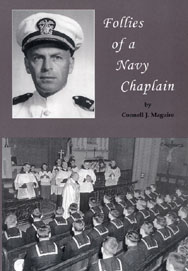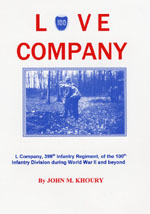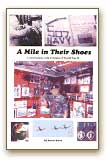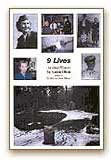©1997, 2009, Wally Hoffman
Wally Hoffman of Olympia, Wash., was a crew member on a B-17 during World War II. He took part in a remarkable 35 missions, and has begun writing his memoirs with the help of a course at the Virtual University. In a special guest Story of the Week, Wally describes his first mission.
Suddenly a flashlight was shining in my face, and a voice from out in the darkness was telling me, "Breakfast at 4 and briefing at 5." I lay there thinking, "What a hell of a way to be woken up," and then I heard those around me also starting to stir. It hit me — this was it! — I was going on my first mission.
All the training was over, and it was now either put up or shut up. I wondered if I would be here tonight, climbing back into my bed, or would someone come in and roll up the mattress, as I had seen done too many times in the past two weeks?
I rolled out of the sack and shaved in cold water. We were advised that whiskers and oxygen masks don’t mix. I jumped in and out of the cold shower, and that really woke me up. I proceeded to dress in T-shirt, GI underwear, plus wool pants and shirt, as we dressed in layers to retain body heat. The B-17 was open to the elements with no heat, and the temperature was always minus 35 to minus 75 degrees without any wind-chill factor.
There was no conversation, as everyone was buried in their own thoughts. I wondered what had happened to all that banter last night about what the boudoir commandos and sexual athletes were going to do when they got home or to London.
My own thoughts were not on the mission or how rough it might be, nor even on where we might be going. I was thinking: Will I be able to perform? Can I do everything right?
I slowly made my way through what seemed like total darkness to the combat mess. Here, in contrast, everyone was talking, but it was all small talk and trivial matters that was a guise to relieve the heavy hand of tension that lay on all of us.
I was immediately hit with the thick smell of frying eggs and bacon which clung to the air. A combat breakfast was always fried eggs, bacon and hotcakes. On other days it was powdered eggs and spam, or "SOS" — s*** on a shingle — which is creamed chipped beef on toast. With a huge knot in my stomach and at 4 o’clock in the morning, who is ready to eat? I can still see those eggs staring up at me!
As a crew, we all sat down together. Resnik wolfed down his breakfast and was looking at Bob’s untouched plate. Bob said, "Take it," and pushed the plate towards Resnik in agitation. Nothing ever seemed to bother Resnik and everything worried Bob.
I picked at a few bites, and the next thing I knew we were outside in the dark, and it was only 4:15 — what do we do for the next 30 minutes? As we strolled over to the briefing hut, I was thinking it seemed only yesterday at Washington State University that we all raised our hands and said "I do" as Aviation Cadets. We were told to go home and wait for orders. This was only the beginning of the military adage we were to hear only too often, "Hurry up and wait."
What a long, hot trip it was from Seattle to San Antonio, and as we were driven through the main gate of Kelly Field we were greeted with the shout, "You’ll be sorry!" We soon found ourselves in the military regimen of turning 90-degree corners, sitting at attention by using only four inches of the chair, and eating square meals by making only very specific 90-degree movements from your plate to your mouth. When we became upperclassmen, we soon inflicted the same treatment on the new class.
After the completion of training, it was then on to Plant Park in Tampa, Fla., for crew selection, then from Drew Field in Tampa to the Overseas Training Unit, and finally to Hunter Field in Atlanta for overseas equipment including a brand-new B-17.
The next day we were off to Europe by way of Dow Field, Bangor Me.; Gander, Newfoundland; and across the Atlantic to Prestwick, Scotland, where they took that brand-new plane from us. We were then sent to Stone, a small village in Central England, and finally here to the 351st Bomb Group at Polebrook, which is on the east coast of England. Immediately all the training we received in the Overseas Training Unit started all over again, only this time it was different — this was for real! We flew the pattern for Polebrook, which is a rectangular course around the field taken prior to landing. As we were taxiing away from the runway after landing we noticed that all the planes had a different symbol on the tail. That was when the penny dropped — we had landed at the wrong field — that was how good we were. Finally, we were now waiting for a combat briefing.
The Briefing Room door swings open after we’ve seemingly been holding our breaths for an hour. We are immediately stopped at the door by the M Ps, who look at our IDs and then check off the crew lists for the mission, for there is very tight security. Inside everyone seems to be talking at the same time, at the top of their voices, making all kinds of wisecracks. Later I find that this is the means of relieving the tension and anxiety. You can feel the fear in the room, although it is clear that everyone has confidence in their training and in one another.
In the front of the room is a stage with a huge map that is covered by a curtain. We soon hear in a very loud voice — "Ten-Shun!" Everyone jumps to their feet and there is instant silence in the room as the Group Commanding Officer and his entourage march down the center aisle. The colonel then tells us to fly our formations as if we are on parade. He also says what good crews we are, and how well-prepared the group is for this mission. He then proceeds to wave the flag by telling us that this is but another step in the total annihilation of Germany.
The colonel then orders the curtain drawn. This is followed by a chorus of "oohs" and "aahs." We watch in fascination as the red yarn on the map winds its way in all directions from the base, finally ending up at Cologne. We would learn later to look for the amount of red yarn left outside the map, which would tell us how long the mission was going to be.
We listened intently as we were told there would be four squadrons of 12 planes and four spares. The Group Intelligence Officer tells us the flak should be light en route, however, there could be considerable flak from the 88-millimeter antiaircraft guns over the target. He steps down and another officer advises us that if we are shot down, which escape routes are available should we reach the ground in one piece, as well as the procedure to follow if captured, and the location of the air-sea rescue boats if we have to ditch in the Channel. The older crews listen with impatience as they have heard all this before. We are an eager, green crew so we listen intently, with the hope that some of this may save our lives.
The people on the stage change, and next up is the Group Navigator, who gives us the critical numbers for altitude and the headings and times for departure, forming at altitude, and for leaving the coast of Germany. He also gives us the schedules for the IP — the point at which you turn to make the bomb run. He tells us the length of the bomb run, and where to turn off the target and reform as a group.
The flight formation for combat and for bombing are different depending on the target. We would go into the formation on the buncher at Kings Cliff, and then look for a green-green flare. He completely covers the details of the takeoff, the forming of individual planes for the elements. The elements into squadrons, and the squadrons into the groups. How the groups will form into wings, the wings into divisions, and the makeup of the total attacking force.
The group bombardier gives us the information on bomb loadings, fuse settings, the bomb run and the aiming point. We would be carrying 14,000 pounds of 500-pound bombs, and 2,800 gallons of 100-octane fuel. The IP would be six minutes from the drop point.
The intelligence officer returns and tells us, "That’s it. This mission looks as if it should be a milk run, and when you land come immediately to the debriefing room." For every mission like this, the intelligence officer could very well end up sitting at an empty table with no crews to debrief and the report sheets never completed. He would think about those missing crews who do not show up at the debriefing. They may have had a wing blown off, or their plane might have blown up in flames, the screams of the men, and parachutes that failed to open.
We made our way to the individual briefings for information on the radio frequencies to use, and emergency procedures. The alternate fields to use for emergency landings, and other detailed information as it applied to each crew. We then picked up our flimsies, which contain the written orders detailing information for individual participation in the mission.
We proceed to pick up our survival kits, which contain maps, currency, malted milk tablets and Benzedrine, among other things, and then shove our way into the overheated ready room to put on our bulky flight gear. This consists of a green nylon electric suit worn over your uniform, heavy flight pants and jacket, along with the fleece-lined flying boots and oxygen mask. On top of all this there is a Mae West, an individual life preserver to keep us afloat should we end up in the Channel. Then a parachute harness. The bulky sheepskin-lined boots are no good for walking so we also attach a pair of GI shoes to our parachute harness should we be shot down. This is a lot of equipment, but if you are to survive at 30,000 feet in rarefied air in an open plane you must ward off temperatures of minus 35 to minus 75 degrees, plus have oxygen to breathe. Planes have returned to the base totally unscarred by enemy bullets, but the men inside had hands or feet that had been so badly frozen in the sub-zero temperature that they had to be amputated. It did not make it any easier if it was not a bullet or flak that made a man legless for the rest of his life.
We also left all of our personal belongings such as pictures, billfolds, etc., in our flight locker. In the parachut loft where we picked up our parachutes we noticed for the first time the sign, "If it doesn’t work, bring it back."
We filed outside and waited for a truck to take us out to the revetment where our plane was parked. When we arrived at the hardstand we were met by the crew chief, who was a maniac for perfection, as well as a mother hen to the plane. We found out later that this was true of all the crew chiefs to both the planes and the crews who flew them. These same ground crews would be out on the hardstands on every mission sweating out the safe return of the crews and the planes. All of us who flew never lost sight of the dedication and work of these unsung heroes for keeping our planes in the air.
After getting our gear and guns on board, the crew chief then reviewed all the latest work his crew had done on the plane, and said, "Don’t you dare scratch it up or lose her, I want that girl, ‘Morning Delight,’ back in good shape!" We did a close pre-flight check, meanwhile the props were run through to make sure there were no oil locks in the engine cylinders. We went through the pre-flight list not once but twice, then the fuel trucks came by and topped off our tanks. I will never forget that sickly sweet smell of aromatic 100-octane gas. Everyone then sat around waiting for the flare to start the engines (later we would use this time to get a few extra minutes’ sleep). All too soon there was the flare to start engines, and everyone scrambled to their positions.
All four engines started on the first try, and all the gauges checked out. Soon there was another flare to start taxiing. What a sight — 40 planes moving nose to tail all in line along the perimeter track. Once we reached the end of the runway, we stopped at a 45-degree angle to the runway, and checked the mags, engine, etc. We were then signaled onto the active runway (each plane took off at 20-second intervals). The engines were run up to 35 inches manifold pressure, and the brakes were kicked loose. We were on our way! As we trundled down the runway, I was thinking, had I done everything that I should do?
All of a sudden I realized that here we were, halfway down the runway, and we were only going about 50 miles per hour, and it takes at least 115 mph for this bird to get off the ground. As I watched the end of the runway coming up, I heard 110 mph, then 115 and the plane was struggling to be airborne. Trees at the end of the runway passed well below us as the flaps and wheels came up, and we started our turn. The plane now felt like a feather and was eager to go. We set for maximum climb and turned on a heading for the King’s Cliff Buncher.
We are soon at 10,000 feet, so everyone puts on their oxygen masks. The bombardier now will be making an oxygen check with all the crew every ten minutes, to make sure they are all right and no one is suffering from anoxia, because the B-17 was not pressurized. At 20,000 feet over the King’s Cliff Buncher there are planes milling around everywhere, and no one can see any green-green flares. The tail gunner finally tells us he has located the flare at 6 o’clock, so we make a 180-degree turn and soon are safely tucked in our allocated position as tail-end Charlie.
As we leave the coast of England, we are again climbing to 28,000 feet (the free air temperature was minus 50 degrees). Below us is the Zeider Zee, and all too soon, Germany. Everyone is burning their eyes out looking for fighters, and so far only some flak bursts can be seen in the distance. We now make a right turn onto the initial point for Cologne that we must maintain for six minutes until the bomb drop.
All I can see ahead of us is solid black smoke from the flak barrage, and the sky is suddenly alive with energy beyond belief. You could walk on it! There are sudden flashes of red, orange and yellow, angry flashes of brilliant light that seems to leap at you without warning. The flak all seems to be intent on getting a winged machine with its loaded bomb bays, and the ten vulnerable men it carries. We make our way through the ever-increasing black mass of exploding flame and smoke of the 88-millimeter flak guns. Those beloved B-17s forge steadily ahead through a tornado of steel splinters and flame that spreads hot chunks of metal through both men and planes. The exploded steel is everywhere as it crashes into wings, engines, bulkheads, airplane bodies, and the men who are flying. If you can see it burst, then it has not hit you. I look at my watch: It is 10 after, and what seemed like a half-hour later, I look again and only 30 seconds have gone by.
Suddenly there is a huge flash and a bright angry flame with a huge release of energy to the right and in front of us. Then there is the stunning slap of concussion as the flame seems to go directly to the core of the flying fortress, and then into the bomb bay to the fuses of the 500-pound bombs. This all occurs in a few thousandths of a second. The entire B-17 and its 10-man crew have vanished into a searing ball of fire as the 100-octane fuel is consumed. There is nothing left except a monstrous smudge as a B-17 and 10 men have forfeited their lives into nothing but bits of flaming debris. That was the moment where actuality set in.
The waist gunner reports a B-17 sliding off on one wing out of the formation and it soon is observed spinning out of control at 4 o’clock. There is one parachute which seems to hit the tail and then is flung aside. We see it fall away, a lifeless rag doll falling five miles to the earth below. We all are silently shouting, "Get out! Get out!" Soon there are three more chutes that come fluttering out, then no more. No one says a word, but we are all thinking, "But by the grace of God, that could have been us."
The plane is turned over to the bombardier, and we can see the Rhine River winding through Cologne, plus the Cologne Cathedral (after continual bombing, this cathedral still stood at the end of the war). In the nose the bombardier is searching for his aiming point that is the rail marshaling yards just across the Rhine River. The bomb run is good, however, it seems we will never reach the bomb release line. We are thinking the bombs must be hung up on the shackles in the bomb bay when suddenly there is a series of little jerks as out come the bombs with their death and destruction on the way to Germany. We then hear the welcome sound over the intercom, "Bombs away!" Someone yells, "Let’s get the hell out of here. I don’t think these people like us."
The trip home came easy. Soon we were over the Channel and down to 10,000 feet, and finally, after about eight hours, off came the oxygen masks. What a relief! We passed over the field at Polebrook, then peeled off and made our landing in proper order, promptly taxied up to the hardstand and put that venerable B-17 down. We all thought, "Holy cow! We made it. No nicks, no bruises, and we didn’t fire a shot."
The plane, however, looked as if someone had tried to make a sieve out of it. The crew chief told me later that we picked up 176 holes from the flak. According to statistics, our life expectancy was four missions, so I guess we will be okay for three more.
We were still getting our gear out of the plane when the truck came to pick us up and deliver us to the ready room where we changed clothes and turned in our gear. Next it was "debriefing," where we were quizzed as to the appearance of the flak, and where we encountered it. What was the time, and where were we when we saw the B-17 that exploded in front of us? What about the B-17 we observed spinning out of control and going down? We were really naive as we had only watched in fascination at these two incidents, and had made no check as to the time or location.
As we left the debriefing, the medics were available, offering two ounces of Old Crow whiskey if you wanted it. The Red Cross was also there, selling coke for the mix and with donuts and coffee. We were totally drained from all that time at high altitude plus mentally exhausted, so on our arrival at the combat mess, who wants to eat? We just wanted to go to bed and what was leftof that momentous day wound down and the adrenaline wore off.
Thus ended one of the most memorable days of my life — one that I would remember for the rest of my days.
----






